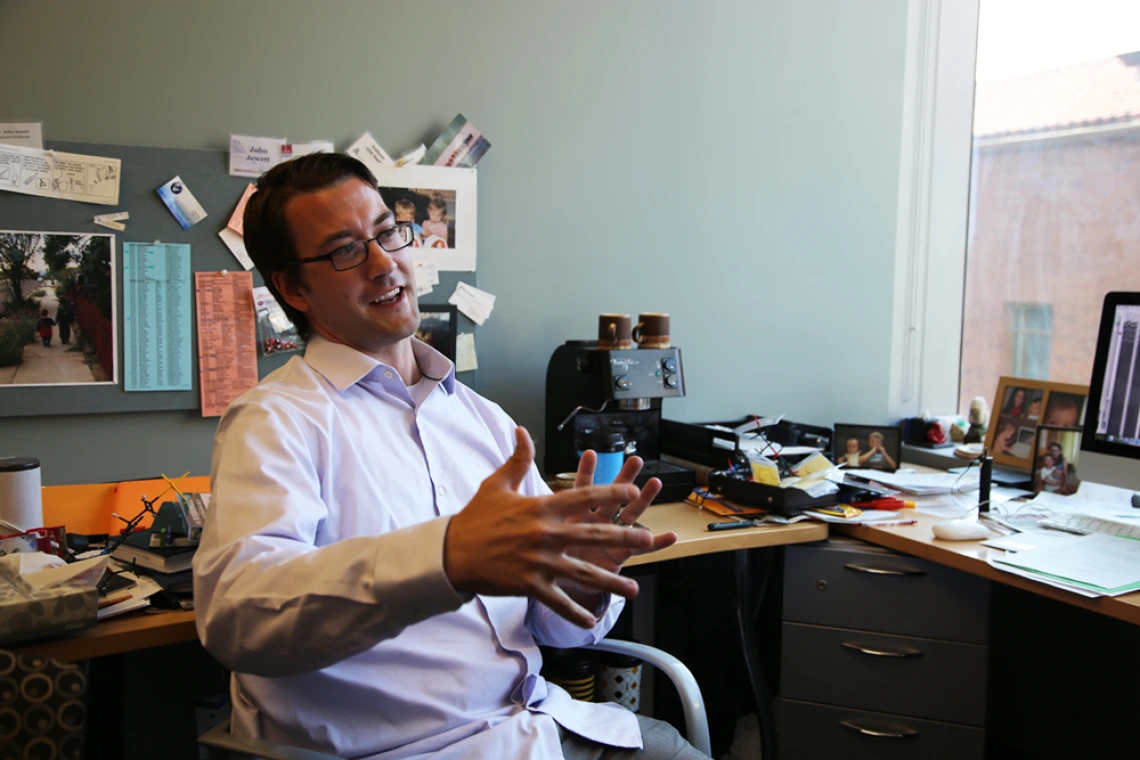Prep and Polish: TLA Asset Demo Program Readies Inventions for Commercialization

In his lab at the Department of Chemistry and Biochemistry(link is external) (CBC) at the University of Arizona’s College of Science(link is external), Assistant Professor John Jewett(link is external), Ph.D., made a surprising discovery in his quest to understand and neutralize the dengue fever virus. Dr. Jewett and his team happened upon a unique class of molecules called triazabutadienes, which demonstrate remarkable bonding behavior in water. This inspired Dr. Jewett to branch into the material chemistry world and solve a problem associated with underwater adhesives. Simply put, it’s hard to make materials stick together under water – unless you have a reaction engineered for that specific purpose.
“We discovered a novel method of synthesis for bonds in aqueous solutions,” Jewett explains. “These material applications are not really a focus in our group, but it’s always cool, as a chemist, to find a new way to make something on the macro scale based on a deeper understanding of molecular interactions.”
This sort of serendipitous outcome from - research is exactly what Paul Eynott, Ph.D., TLA’s licensing manager embedded in the College of Science, keeps an eye out for. After Jewett brought the discovery to his attention, Eynott worked closely with him to identify a commercial use and, in partnership with TLA Business Intelligence Unit Manager John Jackson, Sr., connected him with Jim Butler, a University of Arizona alumnus and graduate of the Eller College of Management now serving as CEO of HJ3 Composite Technologies.
“Our experience with TLA has been very professional.”, Butler comments. “Their team is focused on supporting Dr. Jewett’s proof-of-concept which helps greatly improve our commercialization efforts.
With funding from Tech Launch Arizona’s Asset Demonstration Program (previously known as the Proof of Concept program), Jewett and Butler are putting the underwater adhesive tech to the test, analyzing its potential for use in underwater construction and repair. The potential value of the adhesive in repairing critical and fragile submerged structures, such as the nation’s dam systems, is enormous.
This facilitation of both technological development and economic growth is a direct realization of the strategies outlined in the Never Settle strategic plan and UA President Ann Weaver Hart’s drive for the University to “adopt innovative practices based on transparency and rewarding productivity, effectiveness, and entrepreneurship”.
The Asset Demonstration Program is the keystone in this process, and has resulted in the availability of $1.1M to be deployed in Fiscal Year 2016 towards the development of technology like Jewett’s adhesives, and fields as diverse as non-opioid pain relief drugs, high-performance capacitors, mine safety technology, augmented microscopes, alternative battery formulations, emotional intelligence software and cardiovascular therapy.
Of that $1.1 M in available funding, TLA has awarded a total of $400,000 so far this fiscal year.
The program has been shepherded by Sherry Hoskinson, Director of Business Resources at TLA. When TLA began, it was one of the organization’s first major programs, offering competitive awards of about $40K each.
While program awards are now non-competitive, only those technologies ineligible for traditional research support are eligible for Asset Demonstration funding. Such technologies are generally in their infancy in terms of market readiness. To ensure success and consistent movement towards the goal, funded projects begin with a clear scope of work that is divided into milestones, with incremental funding awarded when milestones are met.
“In our first year we thought we’d get about 20 applications. We got 46, which was exceptional,” she says. “Since then, we’ve broadened the program from just proof of concept to full asset demonstration, bringing technologies much closer to commercialization. The response from the UA inventor community has been fantastic. The current program isn’t formulaic, it represents a commitment to take a promising science that our inventors and advisors tell us could align with market drivers, and through the technology development work, demonstrate the veracity and strength of that alignment.”
Asset demonstration strategically supports the work of the UA inventor; to bring their technology closer to market readiness, additional resources such as in-depth market analyses from TLA’s Business Intelligence team and the expertise of executives- and entrepreneurs-in-residence are brought in to help guide the inventor’s next steps.
Jewett’s underwater adhesive is a sterling example of the processes TLA facilitates, and highlights the strength of the office’s approach. In general, the progression of an innovation from lab bench to licensed technology, it’s development from an idea to a novel and promising market-ready product, and potential for future economic impact are all carefully guided by TLA and the network of local and national alumni and business advisors it brings into the ecosystem.
“It has been an interesting three-year ride to see the creation and evolution of the advisory network and the asset demonstration program come together as resources in our technology commercialization toolbox”, says David Allen, VP of TLA. “We will continue to hone these resources as we deploy them across a wide array of inventions and technology concepts being generated by UA’s highly creative faculty.”

